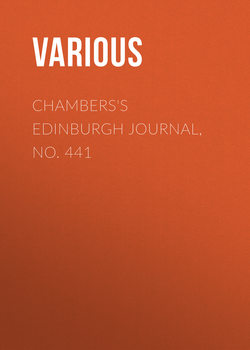Chambers's Edinburgh Journal, No. 441

Реклама. ООО «ЛитРес», ИНН: 7719571260.
Оглавление
Various. Chambers's Edinburgh Journal, No. 441
UNFASHIONABLE CLUBS
ARAGO ON THE SUN
BARBARA'S SEA-SIDE EXCURSION
MR JERDAN'S AUTOBIOGRAPHY
CRIMINAL TRIALS
A NIGHT IN A GERMAN WOOD
AN A.D.L.L. ADVENTURE IN LIVERPOOL
'TWENTY-FOUR HOURS OF A SAILOR'S LIFE AT SEA.'
EXCESSIVE MODESTY
THE KHUNJUNEE
Отрывок из книги
In the Annuaire of the Bureau des Longitudes, recently published in Paris, appears a paper by the distinguished astronomer Arago—'On the Observations which have made known the Physical Constitution of the Sun and of different Stars; and an Inquiry into the Conjectures of the Ancient Philosophers, and of the Positive Ideas of Modern Astronomers on the Place that the Sun ought to occupy among the Prodigious Number of Stars which stud the Firmament'—in which all that appertains to the subject is so ably condensed, as to afford material for a popular summary, which we purpose to convey in the present article. The eclipse of the sun of last July, by enabling observers to repeat former observations and test their accuracy, furnished some of the results which serve to complete the paper in question, and which may be considered as settled, owing to the improvements continually taking place in the construction of instruments. Although astronomy is the exactest of sciences, its problems are not yet all fully solved; and for the determination of some of these, observers have to wait for years—in certain instances, for a century or more, until all the circumstances combine for a favourable observation. From the days of the Epicurean philosopher, who, judging from appearances, declared the sun to be no more than a foot in diameter, to those of living calculators, who give to the orb a diameter of 883,000 miles, there has been a marvellous advance. In these dimensions, we have a sphere one million four hundred thousand times larger than the earth. 'Numbers so enormous,' says M. Arago, 'not being often employed in ordinary life, and giving us no very precise idea of the magnitudes which they imply, I recall here a remark that will convey a better understanding of the immensity of the solar volume. If we imagine the centre of the sun to coincide with that of the earth, its surface would not only reach the region in which the moon revolves, but would extend nearly as far again beyond.' By the transit of Venus in 1769, it was demonstrated that the sun is 95,000,000 miles from the earth; and yet, distant as it is, its physical constitution has been determined; and the history of the successive steps by which this proof has been arrived at, forms one of the most interesting chapters in the progress of science.
It was in 1611 that Fabricius, a Dutch astronomer, first observed spots on the eastern edge of the sun, which passed slowly across the disk to the western edge, and disappeared after a certain number of days. This phenomenon having been often noted subsequently, the conclusion drawn therefrom is, that the sun is a spherical body, having a movement of rotation about its centre, of which the duration is equal to twenty-five days and a half. These dark spots, irregular and variable, but well defined on their edge, are sometimes of considerable dimensions. Some have been seen whose size was five times that of the earth. They are generally surrounded by an aureola known as the penumbra, and sensibly less luminous than the other portions of the orb. From this penumbra, first observed by Galileo, many apparently singular deductions have been made: namely, 'The sun is a dark body, surrounded at a certain distance by an atmosphere which may be compared to that of the earth, when the latter is charged with a continuous stratum of opaque and reflecting clouds. To this first atmosphere succeeds a second, luminous in itself, called the photosphere. This photosphere, more or less remote from the inner cloudy atmosphere, would determine by its outline the visible limits of the orb. According to this hypothesis, there would he spots on the sun every time that there occurred in the two concentric atmospheres such corresponding clear spaces as would allow of our seeing the dark central body uncovered.'
.....
Still, there remained something more to be determined. The existence of the photosphere being proved, the question arose—was there nothing beyond? or did it end abruptly? and this could only be determined at the period of a total eclipse, at the very moment when the obscuration of the sun being greatest, our atmosphere ceases to be illuminated. Hence the interest felt in an eclipse of the sun of late years.
In July 1842, at a total eclipse of the sun visible in several parts of the continent, the astronomers noticed, just as the sun was hidden by the moon, certain objects, in the form of rose-coloured protuberances, about two or three minutes high, astronomically speaking, projected from the surface of the moon. These appearances were variously explained: some supposed them to be lunar mountains; others saw in them effects of refraction or diffraction; but no precise explanation could be given; and mere guesses cannot be accepted as science. Others, again, thought them to be mountains in the sun, the summits stretching beyond the photosphere; but at the most moderate calculation, their height would have been about 60,000 miles—an elevation which, as is said, the solar attraction would render impossible. Another hypothesis was, that they were clouds floating in a solar, gaseous atmosphere.
.....